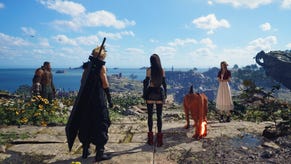Final Fantasy 7 Rebirth on PS5 Pro delivers huge image quality improvements at 60fps
Comparable - and better in some respects - than the standard PS5 at 30fps.
Final Fantasy 7 Rebirth is a highly acclaimed game - and often a very good looking one. Packing incredible character modelling, highly detailed open world environments, and beautiful, particle-packed combat, the game certainly has some very strong visual highs. However, its performance mode was less impressive, let down by poor image quality fed by lower rendering resolutions and a blurry final resolve - but all that's set to change with the arrival of new Sony hardware.
The good news is that the upcoming PlayStation 5 Pro upgrade greatly overhauls the visual quality. It seems that Sony's PSSR upscaling delivers greatly improved, sharper-looking rendering, providing a FF7 Rebirth experience with far less compromise. We've got just seven minutes worth of broadcast-grade ProRes footage - a single snapshot of the Pro version of the game - but what we've seen so far looks like a genuine, night and day improvement.
The Final Fantasy 7 Rebirth b-roll is an uninterrupted sequence covering the beginning of chapter two, the first gameplay segment set in an open-world space. The footage is unlabelled, but the one visual mode featured is targeting 60fps, just like the PS5's performance mode. The intro cutscene shows off the impressive fidelity the PS5 Pro is capable of, delivering a crisp, sharp 4K image - a far cry from the blurry and imprecise 1080p-like rendering featured on the base console at the same 60fps update.
It's possible to make out far more detail across the environment, especially in high frequency texture detail and fine tufts of foliage. Skin textures really shine on Pro, with the specular sheen on Barrett, for example, revealing pore detail that was smeared before. You can actually make out strands of hair on Tifa in close-up and dithering has been minimised relative to base PS5.
Some of the quirks of FF7 Rebirth's TAA resolve have been fixed too and ghosting is no longer really an issue. Certain camera moves tended to cause ugly trails of duplicated detail, and I didn't notice it popping up nearly as much during this footage, though in some moments I did spot some more minor ghosting. Also, distant trees no longer appear oddly transparent and shimmery, and have a more solid, stable look on Pro.
If we step into gameplay, the same advantages continue to be evident. FF7 Rebirth packs a lot of geometry into every frame, boasting primitive shader-powered polygonal detail, and the PS5 Pro simply handles this much better than the base console. Ghosting on camera movement is much harder to spot on the Pro as well. Combat frustrates the base machine a little, with blurry particle effects and poor image clarity producing a muddy look. PS5 Pro handles this scene impressively - much better than I was expecting - resolving crisp 4K-like detail even in relatively fast combat scenes. The motion blur looks quite pristine and is relatively artifact free. Particle effects look generally good in motion, though some freeze-frames reveal a slight chunkiness relative to the rest of the presentation.
That's because Rebirth appears to be using PSSR, or PlayStation Spectral Super Resolution, which is Sony's new machine learning-based upsampling solution exclusive to PS5 Pro. The new console packs a substantial increase in GPU grunt, but the cost of native 4K rendering would likely overwhelm the enhanced console. Instead, Square-Enix has opted for this upsampling solution, taking the game from an average internal resolution of roughly 1152p to 1224p in my counts to 4K. I got counts as low as 1080p, and as high as 1296p - though if we were able to get our own capture here we might be able to see some greater variability.

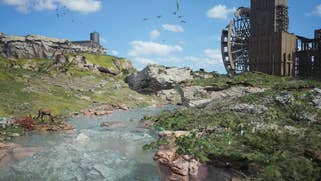
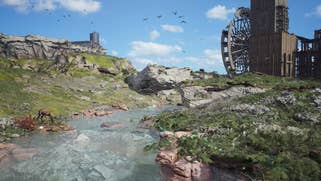
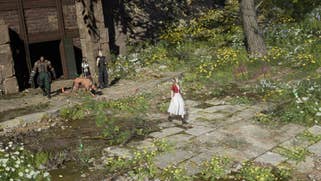

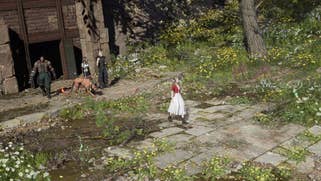



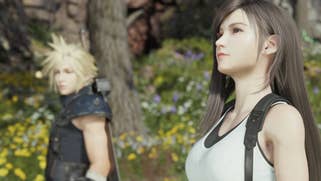
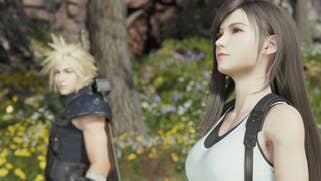
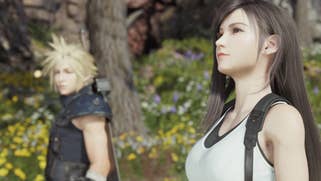
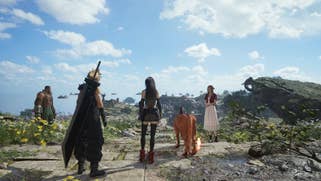

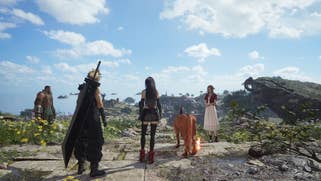
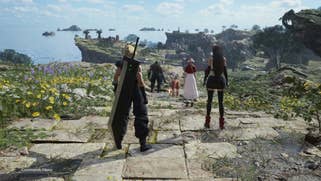
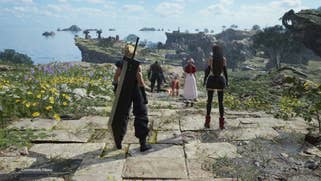

That's very similar to the resolution range of the base game, which hit comparable resolution figures in its performance mode. However, the base console didn't use any form of temporal upsampling, instead taking that final rendered image and simply upscaling it, perhaps using a bilinear or bicubic upscaling solution. The game's final resolve also appeared oddly soft, lacking detail relative to some other games with similar resolutions. Square-Enix also offered a 'performance-sharp' mode, which used a different upscaling method that produced sharper results, albeit with additional blockiness. Preferences here are a matter of personal taste, but neither option offered the kind of image clarity that most other 60fps games on consoles are capable of delivering.
The enhanced GPU capability and machine learning acceleration in PS5 Pro enables Square Enix to hit greatly improved image quality, with the game now genuinely looking like a title rendered at a much higher resolution. But why is PS5 Pro running at similar internal resolutions as the standard machine if it has so much more horsepower? Well, good quality reconstruction-based upscaling has a computational cost of its own but more than that, some aspects of the presentation should be rendered at native resolution output - in this case, 4K. In the footage we looked at, motion blur appears to be rendered at a full 4K, which helps to keep the game looking clean in animation-packed moments like fast combat.
Outside of the image quality boost, the visual outcomes can be a little more mixed. As far as I can tell, key underlying visual settings appear to be a match for the PS5 code. Shadow resolution, for instance, appears very similar, with very sharp detail at extreme close ranges but greatly lowered resolution everywhere else. Foliage pop-in occurs at the same spots in my matched footage as well, suggesting there's been no change to that setting. Pop-in was annoying on PS5 already, and it's more apparent at this higher resolution. Plus, textures appear very similar, with the same occasional bits of low-res art popping up in this gameplay.
Some deeper concerns I have with the game's lighting also seem to have gone unaddressed. Foliage often looks quite good, but smaller vegetation elements aren't effectively grounded with shadows, either with shadow maps, screen-space shadows, or something more far-flung like an RT technique, so they don't have a very natural appearance. I didn't see any evidence that the game's indirect lighting has been improved either, though to be fair the quality of the GI was less of a concern in directly-lit open spaces. We don't have any footage of areas where the indirect lighting was more questionable, like in artificial city spaces.
That's maybe a bit too much of an ask given the game's vintage at this point, and the fact that using PSSR to reach 4K60-like rendering on PS5 Pro seems to take up much of the extra grunt available on the console. There are similar results in the preliminary footage from games like Spider-Man 2 and The Last of Us Part 2, which run at similar, or identical, base resolutions to their PS5 counterparts in their 60fps modes. To reiterate though, PSSR upscaling carries a significant frame-time cost, as does using full-resolution post processing, which isn't mandated for every game but is suggested as a best practice by Sony. Obviously, though, the visual results are what matters, and there the PS5 Pro handily bests the standard PS5 console.
Comparisons to the PS5's performance modes are promising, but perhaps somewhat flattering for the much more capable Pro hardware - so what about the base console's graphics mode? This targeted 30fps and typically rendered at, or close to, a full 4K resolution, with Unreal's TAA used to clean up the image. Rebirth on Pro is delivering a comparable image overall, though there are some differences. In the opening cutscene, the same issue with the distant trees pops up again with the base console footage, while the Pro delivers a more realistic result. The screen-space reflections don't look that great in either view, but I'd probably say the Pro offers a slightly better result. Ghosting is also less of an issue on the Pro.
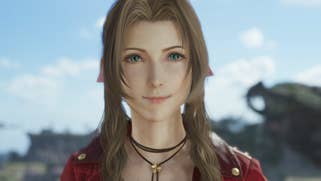
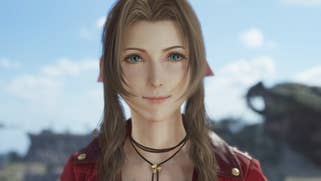
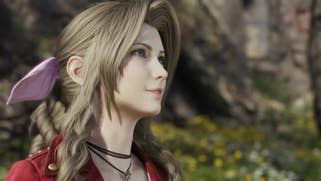

In terms of actual rendered detail, the Pro often actually exceeds the base model, despite its much lower resolution. Details like Barrett's skin texture when viewed close-up show clear improvement, as does the incredibly fine fur detail on Red 13, which is resolved with outstanding sharpness. The graphics mode on PS5 looks good but the image resolve is a little soft given the high internal resolution. It's a reminder that in some scenarios, machine learning-based upscaling can exceed native resolution rendering.
That said, there are some slight pain points on Pro. Tifa's hair in close-up is quite stable on PS5, while the Pro suffers from some odd shimmering and some slightly strange "swimming" artifacts that can be typical of machine learning upscaling. It's a tradeoff then - more detail in exchange for less temporal consistency. As you'll see in the video, there are also some moire pattern artifacts on the back of Barrett's vest. The texture detail here is distorted and doesn't render with the same detail as on base PS5, though in other shots the vest looks fine - we've seen this kind of issue with both DLSS and XeSS. Areas with a subtle depth of field effect don't render correctly either, which is very likely an artifact of the upscaling process.
PSSR also seems to have a tendency to blur together foliage during camera motion. I imagine it's not very noticeable during typical gameplay - and could be easily obscured by motion blur, or a slightly laggy television panel - but it is noticeable in slow motion here. But the graphics mode on PS5 isn't exactly perfect either, presenting foliage with a dithery look when the camera isn't quite still. Combat looks good on both machines, though the 30fps update on the base console looks a bit choppy because of its lack of camera motion blur. I'd really prefer camera-based motion blur was added to the game, and its absence is especially felt in the graphics mode. Ultimately though, both machines look fine with a similar enough rendition of particles - and basically identical object-based motion blur.
Probably the biggest issue here is that the PS5 Pro just isn't that temporally stable relative to the base machine in its graphics mode. In shots without a lot of camera movement, it's fairly easy to find quite a bit of breakup in the image, at least relative to the graphics mode. The image stability overall is more similar to the old performance mode. I don't think this is anything like a dealbreaker here, but the general instability of the image is the biggest sticking point if you are measuring it up against its full-res PS5 counterpart. Here, solutions like DLSS and XeSS typically deliver more temporally stable results. The brief snippets of Ratchet and Clank that we have appear to exhibit a similar problem, suggesting this may be a characteristic weakness of the current version of PSSR.
Overall, I think image quality is similarly good between the two consoles when comparing base PS5 quality mode to the 60fps Pro footage we have, although they can also look fairly different in some areas. The Pro definitely gives you greater image detail, but it comes at the cost of more temporal instability, but the fact that we are getting comparable visuals at twice the frame-rate really speaks to the promise of PSSR and of the Pro more generally. This is basically exactly as Mark Cerny claimed - the Pro provides the high quality graphics that the PS5 is capable of at 30fps, at the higher frame rates that gamers typically prefer.
The very effective use of PSSR does make you wonder about the possibilities for mode selection on PS5 Pro. I think it would be perfectly sensible to only offer this 4K-like 60fps mode on Pro consoles, but if Square-Enix did ship a 30fps mode as well, the studio would have a fair bit of GPU time left over to enhance the game's visual presentation, along with some extra GPU time afforded by adopting PSSR in the first place.
Of course Square-Enix has likely moved most of its focus towards the next FF7 Remake sequel, and personally I hope they are devoting their technical attention towards switching to Unreal Engine 5, but there's at least the potential for something interesting here, even though developer scheduling, resources and the limits of UE4 might set some relatively hard limits on what can be realistically achieved. The graphics mode does operate with similar underlying visual settings as the performance mode on PS5, so at least pop-in and shadow resolution could likely be improved for a potential 30fps Pro outing.
Finally, I wanted to take a look at performance. The PS5 in its performance mode generally ran at 60fps, but could suffer from occasional dips in especially heavy cutscenes or battle sequences. With the limited like-for-like material we have, the standard PS5 has a relatively minor drop in the opening cutscene here, and then a more significant decline later in the second fight sequence. Graphics mode suffers fewer dips, but does drop some frames in that second fight as well.
The good news is that the PS5 Pro footage we have doesn't appear to suffer from the same issues. There are a couple of one-off dropped frames in the opening cutscene, either immediately following a camera cut or a couple of frames after, but you would be very hard-pressed to notice in actual play. Elsewhere, the game is locked at 60fps, even in the second fight scene which is quite demanding. It seems likely that the GPU was becoming overburdened with effects work on the standard console, but the Pro does not have these issues.
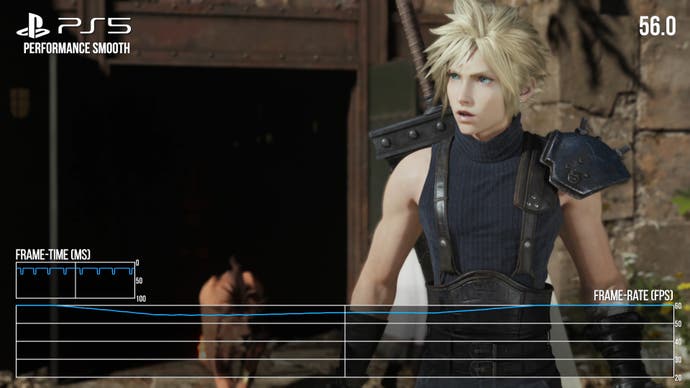
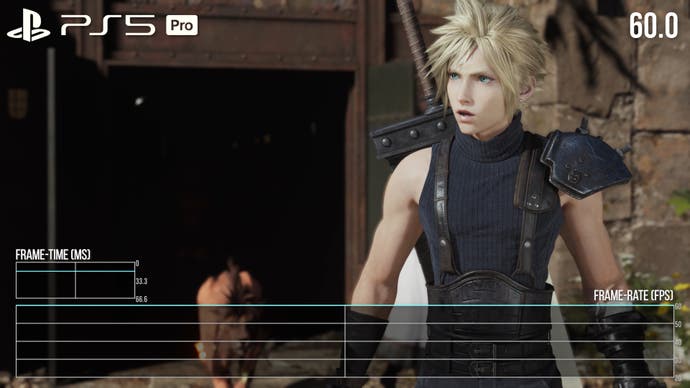
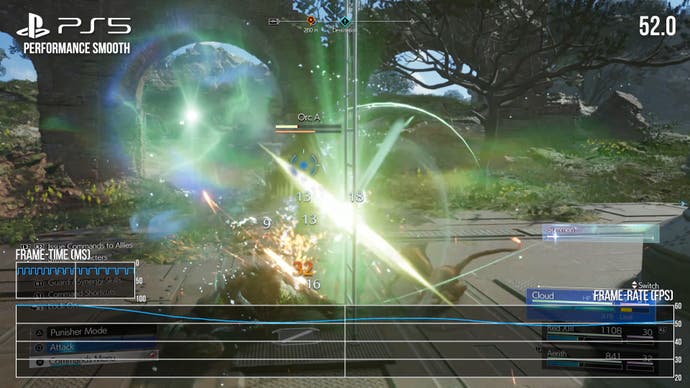
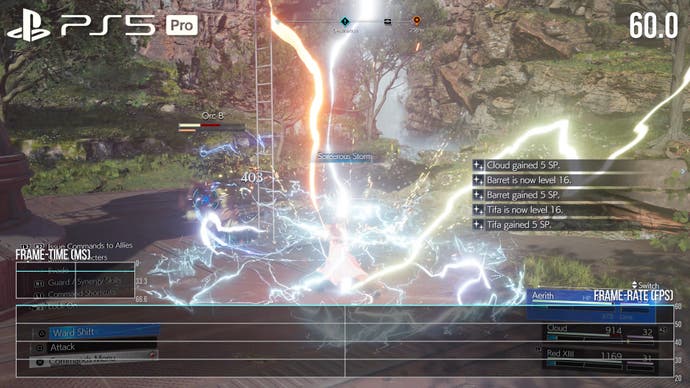
Judging from the available footage, FF7 Rebirth's PS5 Pro upgrade seems very effective. It's a lot like what we'd expect with some of the better Xbox One X upgrades, which took 1080p games often to a full 4K. The native resolution here is far lower, but the perceived resolution is right about there - if not even a bit better-defined than some native 4K games with TAA.
My only real concerns, outside of some quibbles with the current version of PSSR, come down to the likelihood that Rebirth's lighting issues will go unaddressed. It's great to present vast seas of foliage to the player, but it's less great if that foliage doesn't sit naturally with the environment. Likewise, Rebirth's artwork often looks excellent, but without effective indirect lighting some shots can appear somewhat basic. The question is, are we asking for too much here? These criticisms apply equally to the standard PlayStation 5 version, after all.
On the flipside, the game has some soaring visual highs - such as its real-time cutscenes - and those look outstanding on the Pro footage we have, with smooth frame-rates married with impressive image detail. Realistically, squeezing this level of improvement out of the Pro console at this early stage feels like an impressive achievement and perhaps a sign of greater things to come as developers get to grips with the Pro hardware. So if you've been waiting to play Final Fantasy 7 Rebirth, it may be worth waiting a couple months longer, because PS5 Pro seems like the best place to play the Square-Enix epic by a long shot. It's a very effective visual turnaround.







